The Lenovo ThinkPad A285 (12.5-Inch) Review: Ryzen Pro Gets Down to Business
by Brett Howse on December 18, 2018 8:00 AM EST- Posted in
- Laptops
- AMD
- Lenovo
- ThinkPad
- Vega
- Ryzen
- Ryzen PRO
- Ryzen Mobile
- Vega Mobile
Battery Life
Perhaps more than most devices, a small laptop like the ThinkPad A285 is more likely to be used away from the desk, and therefore battery life is fairly important. Lenovo offers a 48 Wh battery inside the 12.5-inch chassis, which like the Intel based ThinkPad X280, has moved away from the dual-battery system and moved to just a single battery which isn’t replaceable by the end-user. This lets Lenovo cut some size and weight, but one of the nice factors of the older models was an optional larger battery for those that needed it, or the ability to swap out the rear battery if needed.
To test the battery life we have several scenarios. Our 2013 battery life test is very light, and with today’s PCs is almost an idle rundown. The newer battery life test is much more CPU intensive, and generally is more representative of what you’d see for basic tasks. Finally, we test the laptop on movie playback. The display is calibrated to 200 nits to keep a consistent brightness across all devices.
2013 – Light
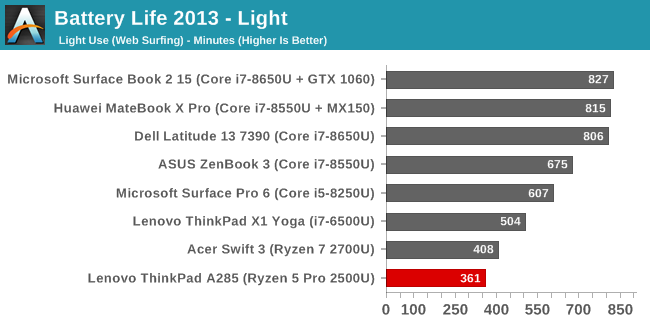
With just a 48 Wh battery, the ThinkPad A285 can’t compete, and sits right at the bottom with the worst battery life we’ve seen in a while, at just one minute over six hours. We’ll dig into why in a minute.
2016 – Web
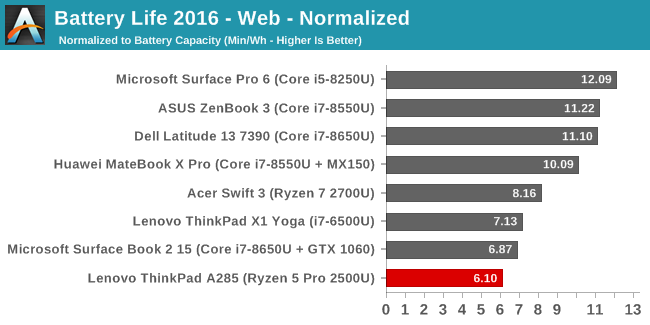
Our newer web test taxes the CPU quite a bit more, and generally knocks down the battery life significantly on any low-powered device. That is the case here, but the difference is not as dramatic as some of the other devices.
Movie Playback
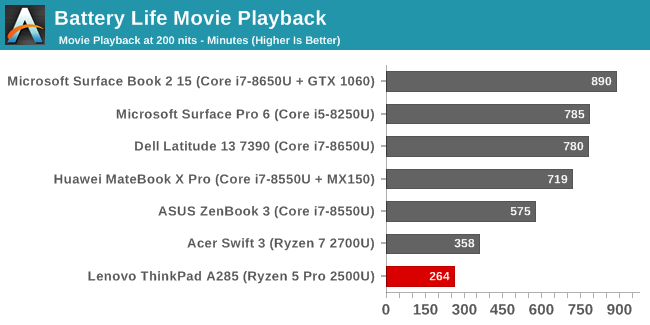
Generally movie playback is the most efficient test we have, but there’s something not right with Raven Ridge and movie playback. The decode can be offloaded to the media block, so in theory the CPU should be in its lowest power state for this test, but surprisingly the A285 fares worse here than in the web test. That result is mimicked by the other Raven Ridge laptop in our graph.
Normalized Results


Finally we remove the battery capacity from the equation to see how many minutes of battery life each device gets per Wh of battery. The Raven Ridge devices sit right at the bottom.
Digging Into Power Draw
On any system there are always various components drawing power at all times. The display is generally the highest power consumer on any system at idle, and the amount of energy it draws varies on the size, brightness, and resolution. For instance, the display of a Surface Book 2 15-inch draws about 7.65 Watts at 100% brightness. Setting the display down to 200 nits drops its power draw to 4.1 Watts. Meanwhile the rest of the system pulls just 1.43 Watts at idle.
Raven Ridge, it appears, has a power draw problem. We saw it on the Acer Swift 3, and we’re seeing it again on the Lenovo ThinkPad A285. The base power draw is quite high, which makes the battery deplete much more quickly than it should. Let’s look at some numbers:
For this test, we've set the display to 100% brightness while the rest of the system is idling, with Windows set to shut off the display after a couple of minutes. The graph above includes both the Surface Book 2 (Green/Blue) and the ThinkPad A285 (Red), plotting the total power draw of each system. Since the display itself is only on for a couple of minutes, the first part of the graph is with the display at 100%, while the remaining section of the graph shows the system's average idle power draw.
Breaking things down, we see that the ThinkPad A285 starts out with an average power draw of 8.62 Watts with its display on and the system idling. Waiting a few minutes for the display to turn off, and we see that the average system power consumption drops by just over 4 Watts to 4.6 Watts. This is a significant drop, but not significant enough. The Surface Book 2 in the same scenario idles at a little more than one-third of this, meaning the A285 – and specifically, the Raven Ridge platform inside – is drawing an additional 3 watts at full idle. This is a huge amount of power to draw at idle, and leads to the less than amazing battery life results on Raven Ridge devices.
Some of the draw will be from the DDR4 memory, since most Ultrabooks leverage LPDDR3 to reduce the power usage, but that is not going to be all of it. It looks like AMD has some work to do in order to get its power usage in check if they want to better compete in the laptop space. They need their Haswell moment.
Charge Time
The flip side of the coin is charge time, and Lenovo tends to offer quite quick charge rates. The ThinkPad A285 ships with a 65-Watt AC Adapter, which is much larger than the adapter that ships most laptops of this size, and it is rated to charge 80% of a charge in just 60 minutes. It connects via USB Type-C.
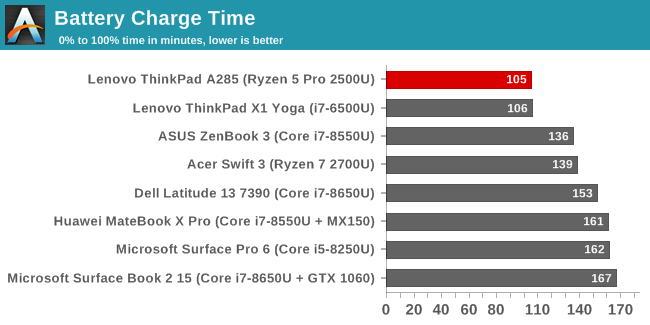
Not only does the 48 Wh battery get filled to 100% in the shortest amount of time, Lenovo even beats the 60 minute time for 80% by seven minutes.


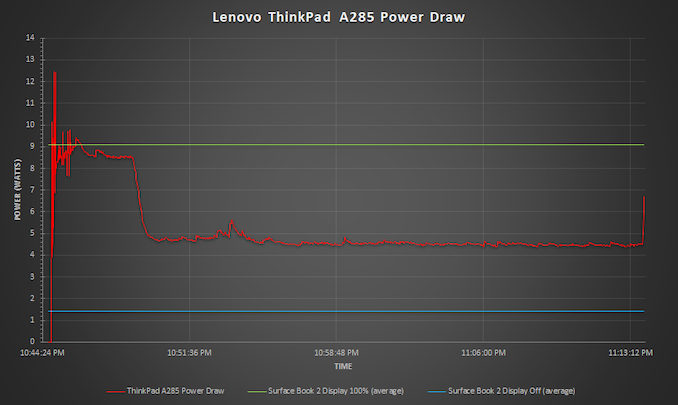
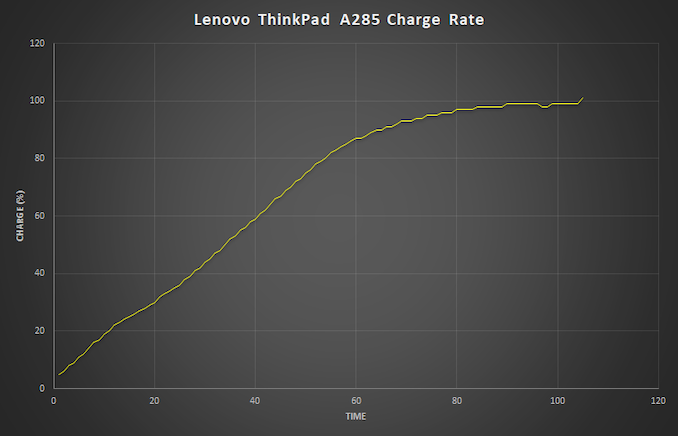








72 Comments
View All Comments
MonkeyPaw - Tuesday, December 18, 2018 - link
I agree. I have a hihg-DPI Lenovo that I dock, and when I undock, I get blurry fonts in Office because my desktop monitor is old-DPI. I’d have to log out and back in each time I docked and undocked, which is not a convenient thing to do going from my desk to a 1 hour meeting and back. We run Windows 10, but we stay a few versions back for testing/stability (I assume).GreenReaper - Tuesday, December 18, 2018 - link
They've had the TN 1366x768 screens for years - I'm using one now (albeit with several other better ones plugged in). It works, but it's pretty bad colour-wise and the low resolution is why sites still need to be designed for such resolutions: they're still sold, new.Spunjji - Tuesday, December 18, 2018 - link
Why do OEMs keep putting capable processors in a chassis with terrible thermal management? If the CPU can't even hit its base frequency under load and yet is *below TDP* then something is very badly wrong with the design.That plus the terrible WiFi seems like unnecessary own-goals. It's a shame. AMD have a lot of work to do to catch up on idle power draw, but they're never going to get the investment necessary if their processors only ever get crammed into half-baked products.
johnny_boy - Tuesday, December 18, 2018 - link
A shame about the idle power draw coupled with a small battery. The screen also sucks but at least it can be upgraded. I was surprised at the performance difference of the iGPUs in the 2500u and 2700u, especially since the CPU tests often ran worse on the 2700u. I wish there were more 2700u laptops available, because that is the sort of iGPU performance I am looking for. And with pretty darn good linux driver support, Ryzen is very enticing (for someone like me).mczak - Tuesday, December 18, 2018 - link
There is just about zero GPU performance difference between a 2700U with Vega 10 and a 2500U with Vega 8 (ok not quite zero but it's tiny). Just about any significant difference between these two comes down to the actual implementation, that is configured TDP, thermal limits, cooling.And apparently Lenovo blew this completely on this notebook.
sfwineguy - Tuesday, December 18, 2018 - link
Sorry to miss something obvious here, but why (per the graphs) did the 2700u underperform the 2500u in some of the CPU tests? Doesn't that confound expectations? Is the 2700u reviewed in another piece that explains how its little brother beats it up in some tests?MonkeyPaw - Tuesday, December 18, 2018 - link
Probably better cooling in the Lenovo, allowing the CPU to stay boosted higher and more often.YukaKun - Tuesday, December 18, 2018 - link
"It would be nice to see a 16 GB offering, but for office tasks, 8 GB should suffice."Oof... That couldn't be more wrong, my dear Brett. The amount of bloatware *cough*McAffee*cough* is just bonkers. 8GB is the *minimum* an enterprise laptop needs nowadays to run a bit less like a hog. For development, 16GB has been the minimum for years (~2013) and now it's moving to 32GB per developer laptop.
Cheers!
HStewart - Tuesday, December 18, 2018 - link
As a developer unless you are using a lot of Virtual Machines, I don't see much of need to go more 16GB of RAM - However, if you a 3D Graphics Artist, I would believe it will be useful for large scene. most of my machines have 16G. My actual work machine for development has 12G but it older 3rd generation i7.A5 - Tuesday, December 18, 2018 - link
Meh, it's not just VMs.GCC will use as much RAM as you'll let it if your project is of sufficient size, not to mention web browsers, Outlook, etc.